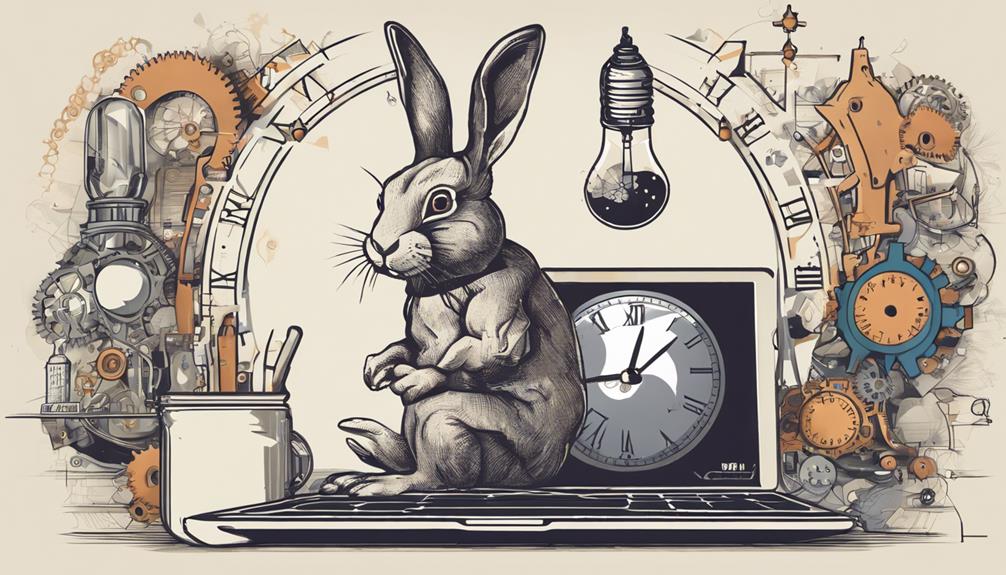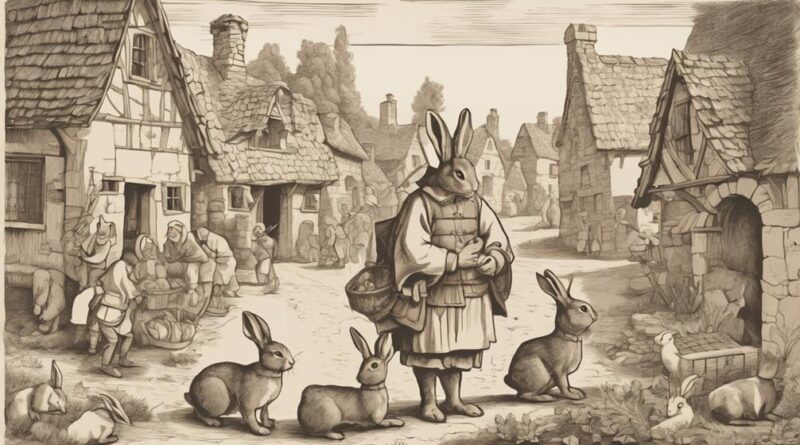7 Key Tips on Rabbits' Historical Societal Role
Discover the rich historical societal role of rabbits. From ancient civilizations to indigenous societies, these creatures symbolize fertility, agility, luck, and mysticism. In Medieval European folklore, they were associated with superstitions and good luck. Asian cultures revered them for virtues like longevity and agility. Rabbits are not just animals but representations of cultural beliefs and values. Their symbolism has evolved to encompass creativity, adaptability, and societal perceptions. Unravel the deep-rooted significance of rabbits in various cultures and societies, exploring their multifaceted roles throughout history.
Ancient Civilizations' Rabbit Symbolism
Ancient civilizations across the world viewed rabbits as symbols of fertility, abundance, and agility, attributing mystical qualities to these creatures that influenced various aspects of their societies. In ancient Egypt, for example, rabbits were associated with the cycle of life, death, and rebirth due to their prolific breeding habits. The Egyptians believed that the hieroglyph for rabbit represented the concept of 'being' or 'existence.' This symbolism extended to the Moon, a celestial body closely linked with fertility and the cyclical nature of life.
Similarly, in Chinese folklore, the rabbit is a symbol of longevity and immortality. The famous legend of the Moon Goddess Chang'e and her companion, the Jade Rabbit, is a testament to the revered status of rabbits in Chinese culture. The Jade Rabbit is often depicted mixing the elixir of life, emphasizing the rabbit's connection to health and longevity.
In Mesoamerican civilizations like the Aztecs, rabbits were associated with both the moon and fertility. The Aztecs believed that rabbits possessed special powers, and their abundance was seen as a sign of good luck and prosperity. Additionally, in some Native American tribes, rabbits were considered tricksters, embodying cleverness and quick thinking.
The widespread symbolism of rabbits in ancient civilizations underscores the universal themes of fertility, abundance, and agility that these creatures represent across different cultures, shaping societal beliefs and practices.
Rabbits in Medieval European Folklore
The significance of rabbits in Medieval European folklore continued to reflect themes of mysticism and symbolism prevalent in earlier civilizations, shaping the cultural perceptions and beliefs surrounding these creatures. In medieval Europe, rabbits held a dual role in folklore – they were seen as both symbols of good luck and carriers of superstitions.
Rabbits were often portrayed as magical beings in medieval art, appearing in illuminated manuscripts and tapestries. They symbolized fertility, abundance, and renewal, reflecting the cyclic nature of life. However, superstitions surrounding rabbits also emerged. For example, some believed that witches could shape-shift into rabbits to evade capture, adding an air of mystery and fear to these creatures.
Medieval European folklore also associated rabbits with concepts of cunning and trickery. Tales often depicted rabbits as clever creatures outsmarting predators, showcasing their intelligence and survival instincts. These stories reinforced the idea that rabbits weren't just passive animals but active participants in the natural world.
The Role of Rabbits in Asian Culture
Exploring the multifaceted role of rabbits in Asian culture reveals a rich tapestry of symbolism, tradition, and significance deeply woven into various aspects of society. In Eastern traditions, rabbits hold a prominent place, symbolizing various virtues such as longevity, fertility, and agility. The cultural significance of bunnies in Asia extends beyond mere symbolism, with these creatures often representing good fortune, prosperity, and even moon deities in different countries across the continent.
In many Asian cultures, rabbits are seen as creatures of luck and abundance. For example, in Japanese folklore, the 'moon rabbit' is a popular figure associated with Buddhist beliefs and is said to reside on the moon, crafting elixirs of immortality. Similarly, in Chinese culture, the rabbit is one of the twelve zodiac animals and symbolizes kindness, elegance, and compassion. The Mid-Autumn Festival, celebrated in several Asian countries, often features rabbit motifs as a symbol of reunion and harvest.
Moreover, rabbits are frequently depicted in traditional art forms like painting, ceramics, and literature, showcasing their enduring presence in Asian cultural heritage. The reverence for these gentle creatures reflects a deep-rooted appreciation for nature and its harmonious balance within Eastern societies. Overall, the role of rabbits in Asian culture transcends mere symbolism, embodying a profound connection between humans and the natural world.
Rabbits as Symbols of Fertility
Symbolizing abundance and prosperity, rabbits have long been revered in various cultures as potent symbols of fertility. Rabbit symbolism in different cultures often highlights the reproductive abilities of these small mammals, associating them with concepts of renewal, growth, and new life. The cultural significance of rabbits as symbols of fertility can be seen in their representation in art, literature, and folklore across the world.
In many ancient civilizations, rabbits were linked to deities and fertility goddesses due to their prolific breeding habits. For example, in Egyptian mythology, the rabbit was associated with the moon and fertility, reflecting the beliefs in rebirth and regeneration. Similarly, in Chinese culture, the rabbit is one of the twelve zodiac animals and symbolizes longevity, fertility, and the moon.
The idea of rabbits as symbols of fertility isn't limited to ancient cultures but continues to hold significance in modern times. In some Western societies, the Easter Bunny, a popular symbol during the Easter holiday, is a representation of fertility and new life. The image of the rabbit bringing eggs and treats to children reinforces the connection between rabbits and the renewal of life.
Rabbits in Indigenous Societies
Within indigenous societies globally, rabbits have played multifaceted roles, intertwining with cultural practices and beliefs in ways that reflect the intricate relationships between humans and nature. In many indigenous communities, rabbits aren't merely seen as animals but hold deep symbolic significance. They're often associated with tribal customs, where they serve as rabbit totems, representing qualities like fertility, agility, and abundance.
In indigenous folklore, rabbits feature prominently in hare mythology, often portrayed as clever and resourceful beings. These stories are passed down through generations, emphasizing the importance of respecting nature and living in harmony with all creatures, including rabbits. The tales of trickster rabbits are common in many indigenous cultures, showcasing the cunning and intelligence attributed to these animals.
Moreover, rabbits are sometimes seen as messengers or guides between the earthly realm and the spiritual world in indigenous belief systems. Their presence in myths and legends underscores their revered status within these societies. Through intricate rituals and ceremonies, indigenous communities honor the rabbit's spirit and seek to learn from its characteristics.
Rabbits in Literature and Art
In literature and art, rabbits have served as captivating symbols and subjects, captivating audiences with their diverse representations and meanings. Rabbits often symbolize fertility, abundance, and agility in literature. For example, in the classic novel 'Watership Down' by Richard Adams, rabbits represent various aspects of human society, from leadership to friendship, creating a rich tapestry of symbolism. Additionally, rabbits are frequently used to convey innocence and vulnerability, as seen in Beatrix Potter's beloved children's stories featuring Peter Rabbit.
In art, rabbits have been depicted in various styles and contexts, showcasing their versatility as subjects. From the playful and whimsical portrayals in children's book illustrations to the more complex and allegorical representations in fine art, rabbits have inspired artists for centuries. The famous painting 'The Rabbit' by Hans Hoffmann exemplifies the meticulous attention to detail that artists have dedicated to capturing the essence of these creatures.
Furthermore, rabbits in art often serve as a metaphor for the human experience, exploring themes of fear, resilience, and the cycle of life. The representation of rabbits in art reflects the cultural significance and enduring appeal of these creatures, making them a timeless source of inspiration for artists across different mediums.
Modern-Day Rabbit Symbolism

The significance of rabbits in modern-day symbolism transcends traditional interpretations, evolving to embody a wide spectrum of meanings in contemporary culture. Cultural evolution has played a pivotal role in reshaping the symbolic significance of rabbits, moving beyond their historical associations to encompass new layers of meaning. In today's world, rabbits are often seen as symbols of fertility, abundance, and creativity, reflecting their role in various cultural narratives and belief systems.
Contemporary interpretations of rabbit symbolism also highlight their societal relevance in addressing themes such as agility, quick-thinking, and adaptability. Rabbits are frequently used in advertising and branding to convey messages of speed, agility, and innovation, tapping into their symbolic associations with swiftness and resourcefulness. Moreover, rabbits have become emblematic of environmental conservation efforts, symbolizing the need for sustainable practices and harmony with nature.
The modern-day symbolic significance of rabbits is multifaceted, reflecting the diverse ways in which these creatures are perceived in today's society. From representing innocence and playfulness to embodying cunning and intelligence, rabbits continue to captivate audiences with their rich symbolism and cultural resonance. As society evolves, so too does the symbolic meaning attributed to rabbits, demonstrating their enduring relevance in contemporary culture.
Frequently Asked Questions
How Did Rabbits Impact Rituals in Ancient Civilizations?
Rabbits had a profound impact on ancient civilizations' rituals, influencing ceremonies and holding significant cultural roles. These creatures were often revered for their symbolism, representing fertility, abundance, and rebirth.
Their presence in ceremonies added a sense of mystique and spiritual connection to the proceedings. Through their association with these rituals, rabbits became intertwined with the cultural fabric of societies, leaving a lasting impression on the beliefs and practices of those times.
What Superstitions Surrounded Rabbits in Medieval Europe?
In Medieval Europe, rabbits were linked to various superstitions. People believed that rabbits were connected to witches and were thought to have magical powers. Some believed that seeing a rabbit crossing your path brought good luck, while others thought it was a bad omen.
These superstitions influenced rituals and practices in medieval society, shaping how people interacted with and perceived rabbits during that time.
Are There Specific Meanings Behind Rabbits in Asian Culture?
In Asian culture, rabbit symbolism holds deep cultural significance. The rabbit is often associated with fertility, longevity, and the moon.
In Chinese folklore, the Moon Rabbit is a popular figure symbolizing immortality and selflessness. In Japanese culture, rabbits are seen as a symbol of good fortune and prosperity.
These cultural meanings highlight the rabbit's positive traits and its role as a symbol of auspiciousness in various Asian societies.
Why Are Rabbits Associated With Fertility Symbols?
Rabbits are associated with fertility symbols due to their prolific breeding habits, linking them to concepts of growth and abundance. This connection transcends cultures and has deep roots in ancient civilizations where rabbits were revered for their ability to reproduce rapidly.
The cultural significance of rabbits as symbols of fertility has endured through generations, symbolizing renewal, prosperity, and the cycle of life across various societies worldwide.
How Did Indigenous Societies View Rabbits Spiritually?
When exploring indigenous beliefs, rabbits held significant spiritual connections. These societies often viewed rabbits as symbols of fertility, abundance, and renewal.
The presence of rabbits in their folklore and ceremonies symbolized a deep respect for nature's cycles and the interconnectedness of all living beings.
Through rituals and stories, indigenous communities honored the rabbit as a messenger of prosperity and the natural world's delicate balance.
Conclusion
Overall, rabbits have played a significant role in various cultures throughout history, symbolizing fertility, luck, and creativity.
From ancient civilizations to modern-day society, rabbits have been depicted in literature, art, and folklore, showcasing their enduring presence and cultural significance.
Understanding the historical societal role of rabbits provides insight into the diverse ways in which these creatures have been revered and celebrated across different cultures and time periods.
